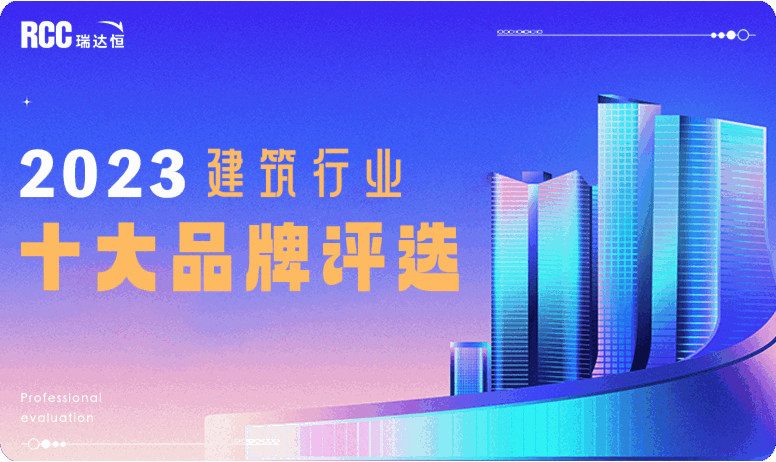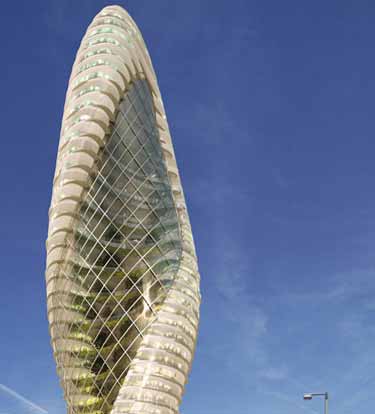第一名:水田共生复合养殖摩天楼
来源:匿名网友投稿 2014-07-04
1. Project statement
项目背景概况
Aquaponic Tower- this is a concept for an idea, a solution to a problem that can be solved with the utilization of the technology we have readily at hand.
We have chosen to address the fore casted rise in population and demand for food and clean air, to avoid the sharp rise in use of transport and to somehow provide our most basic needs.
水田共生复合养殖摩天楼-这是我们提出的一个概念,通过我们现有的科技,解决世界上最严重的问题-过渡甚至失控的人口增长造成的粮食危机,并且由于城市化与交通运输造成的环境与空气质量的恶化。
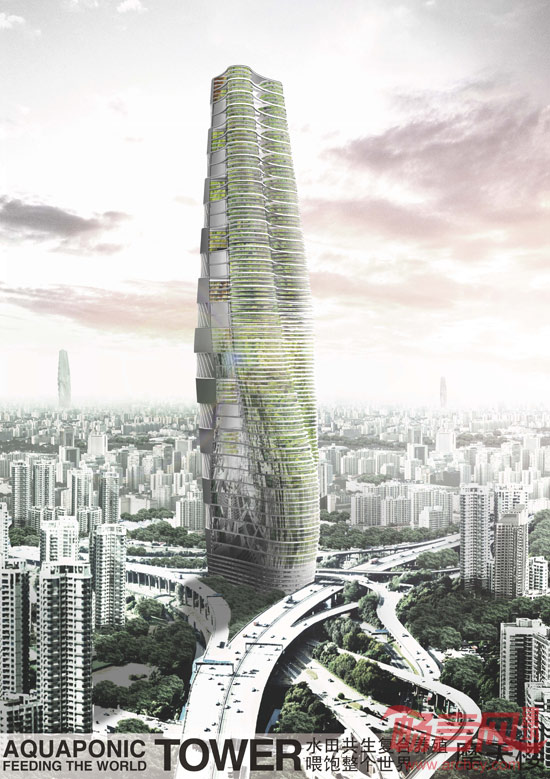
效果图(一)
Growth of Population
UN world population statistics indicate we have a 6.8 billion person population on the planet. This number is set to increase by 34% by 2050, giving us the massive task of providing for 9.1 Billion people. The statistics show that this increase will happen predominantly in developing countries. With malnutrition across the board with a population of 6.8 billion people an increase of 70% (minimum) in world food production is required, new techniques to provide to the bulging population will have to be incorporated.
人口增长
根据联合国的报告显示,现今世界人口为六十八亿人。这个数字在2050年将增长34%,也就是说,届时地球上居住着九十一亿人。根据统计预测,大部分的新增人口在发展中国家。我们的粮食产量必须在现有的基础上增产70%,才能使未来的九十一亿人口不会挨饿。
Urbanization
The United Nations states that 50% of the total world population inhabit urban areas and this number is set to increase to 70% by 2050. Currently the level of food imported into the urban areas requires huge amounts of energy, fossil fuel energy that as of today is a pollutant harming the environment and those living beings that have to inhabit within it. As the city spreads out and the inhabitants become accustomed to a higher standard of living. The free space allowed for farming fish, fruit and meat will become more rare and a vertical approach to food growth will have to be undertaken.
城市化
联合国的数据库的相关报告同时显示,现今世界50%的人口居住在城市,到2050年将有70%的人口居住在城市。为了满足全球50%的城市人口,每天粮食,瓜果蔬菜都从各个运送到各大城市,其消耗的资源是巨大的,同时也是全球变暖的一个重要原因之一。同时城市又在不断的扩张着自己已满足增长的城市人口以及他们对城市生活质量的要求。可以生产瓜果蔬菜,以及鱼类的土地和淡水资源变的越来越稀缺。所以一个竖向的生态系统看似是很必要的。
Current
We require a paradigm shift in the concept of food production. Most developed cities import their food from across the planet, wasting countless amounts of energy in processing and transporting food. The means of production uses many chemicals and poisons to treat the plants and are harmful to the environment.
生产现状
我们认为现有的粮食生产模式需要革新与转变。绝大部分的发达城市都从整个地球运输食品。同时大部分原材料在种植,生产以及加工途径中运用了大量的化学和有毒物质,不仅仅对我们自身身体,同时对整个地球环境产生了巨大的破坏。尤其是珍惜的土地资源。
BEIJING
We have chosen Beijing as a case study city. It is the perfect example of a rapidly expanding urban Mega city. It has grown from a population of 7.5 million to 23 million in 35 years, an increase of more that 300%. It is expected that by 2050 the population of Beijing will be 50 million persons. The development of infrastructure for population sizes of this magnitude have excelled in the fields of economic and industry, but for the provision of food, there has been a stagnation in Beijing's ability to be sustainable and self sufficient. Today Beijing can provide 22% of the fresh fruit and vegetables that the population requires, but current forecasts show that with the expanding urban infrastructure the land available for farming will decrease to near zero by 2050.
A common feature in all large metropolitan cities are large transport hubs hat connect the various circulation systems of the city. Beijing is no different. Currently the city has 25 major transport hubs。
研究城市——北京
我们选择北京为研究城市,在众多超级城市中,北京市最有特色并且最完美的研究对象,他拥有大多数超级城市的特点与缺陷,同时又是一个很特殊的样本。北京在35年间,由一座仅有七百五十万的城市成长为现在拥有两千三百万人口的超级城市,其成长率为300%。根据预测2050年北京的人口将达到五千万人。北京城市人口的增长与了工业,金融,服务产业等的高速发展息息相关。但是城市发展对原有农业结构造成了很大的影响。现今的北京仅仅22%的瓜果蔬菜可以自给自足,但是根据统计及预测,按照现今城市发展速度,2050年之前,北京的可耕作土地将必定趋近于0%。
如果将城市看作一个人造自然系统的话,那么会发现世界各大超级城市的系统是极其相似的,同时,庞大的交通运输维持着整个系统的运行。北京也是一样的。现今北京城区拥有25个重要的交通枢纽,当然,对于一个两千万人口的城市,这还是不够的。
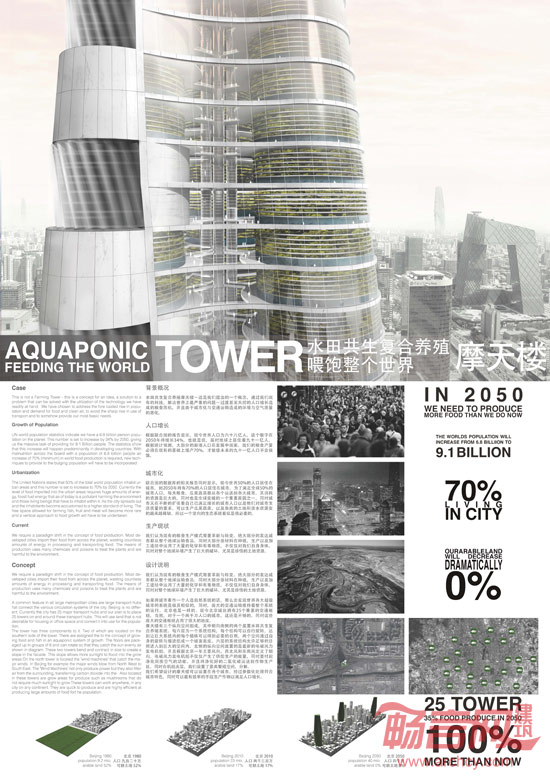
效果图(二)
2. Concept
设计说明
our plan is to place 25 towers on and around these transport hubs. This will use land that is not desirable for housing or office space and convert it into use for the population.
The tower has three components to it. Two of which are located on the southern side of the tower. There are assigned the to the concept of growing food and fish in an aquaponic system of growth. The floors are packaged up in groups of 6 and can rotate so that they catch the sun evenly as shown in diagram. These two towers bend and contract in size to create a slope in the facade. This slope allows more sunlight to flood into the grow areas.
On the north tower is located the ’wind machines’ that catch the major winds. In Beijing for example the major winds blow from North West to South East. The ’Wind Machines’ not only produce power but they also filter air from the surrounding, transferring carbon dioxide into the . Also located in these towers are grow areas for produce such as mushrooms that do not require much sunlight to grow.
These towers can work anywhere, in any city on any continent. They are quick to produce and are highly efficient at producing large amounts of food fort he population.
我们的方案是,在北京的25个交通节点上放置我们的水田共生复合养殖摩天楼。利用交通节点中心无法做为办公及住宅的地块节约了土地成本的同时,又方便运输。
摩天楼有三个纵向空间组成,其中朝向南侧的两个放置水田共生复合养殖系统。每六层为一个系统结构,每个结构可以自行旋转,达到让巨大系统内的每个植株可以得到必要的日照。两个空间通过自身的旋转与缩进组成一个坡面表皮。六层的系统结构允许足够的日照进入到巨大的空间内。北侧的纵向空间放置的是最新的电磁风力发电机组。并且根据北京一年主要风向,西北风和东南风定义了朝向。电磁风力发电机组不仅仅产生了供给生产的能量,同时要付起净化周围空气的功能。并且将净化好的二氧化碳运送到作物生产区。同时在机组夹层,我们设置了菌类繁殖空间,分解。
我们希望设计的摩天楼可以设置在各个城市。经过参数化处理符合城市特色,同时可以最有效率的手段生产作物以满足人口增长。
发表评论
最新评论
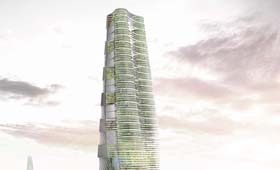
 投稿
投稿



